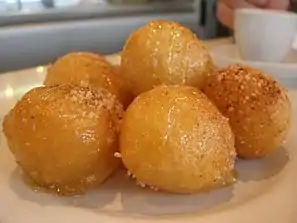Lokma
Lokma are pastries made of leavened and deep fried dough, soaked in syrup or honey, sometimes coated with cinnamon or other ingredients.[1] The dish was described as early as the 13th century by al-Baghdadi as luqmat al-qādi (لقمة القاضي), "judge's morsels."[2][3][4]
 | |
| Alternative names | Loukoumades, Loukmades, Luqmat, loukmat alkady |
|---|---|
| Type | Fried dough |
| Main ingredients | yeast-leavened dough, oil; sugar syrup or honey |
Etymology
The Arabic word luqma (لقمة) (plural luqmāt), means morsel, mouthful, or bite.[5][6] The dish was known as luqmat al-qādi (لقمة القاضي) or "judge's morsels" in 13th century Arabic cookery books,[2] and the word luqma or loqma by itself has come to refer to it.[5] The Turkish name for the dish, lokma, is derived from the Arabic,[6] as is the Greek and Cypriot name loukoumádes.[2]
History
The recipe for Luqmat al-Qadi, yeast-leavened dough boiled in oil and doused in honey or sugar syrup with rosewater, dates back to at least the early medieval period and the 13th-century Abbasid Caliphate, where it is mentioned in several of the existent cookery books of the time. It is also mentioned in the One Thousand and One Nights, in the story The Porter and the Three Ladies of Baghdad.[2][4] The explorer and scholar Ibn Battuta in the 14th century encountered the dish he knew as Luqaymat al-Qadi at a dinner in Multan, during his travels in medieval India, where his hosts called it al-Hashimi.[4]
It was cooked by palace cooks in the Ottoman Empire for centuries and influenced by other countries cuisines of the former countries of the Ottoman Empire in the Balkans, Middle East and the Caucasus.
Regional varieties
Arab countries
Today, in Arab countries of the Persian Gulf, luqaymat, sometimes spiced with cardamom or saffron, are little changed from the 13th-century recipes.[4] In parts of the Middle East they may also be called awameh (عوامة) meaning "swimmer", or zalabya (زلابيا), with numerous spelling variations, though the latter term may also refer to a similar dish made in a long spiral or straight baton shape.[7][8][9] They are traditionally included in times of religious observances; for example in the Levant by Muslims at Ramadan, Jews at Hanukkah, and Christians at Epiphany alike.[7][9][10]
Greece and Cyprus
In Greece and Cyprus, they are called loukoumádes (λουκουμάδες) and lokmádes (λοκμάδες) in Cypriot Greek. They are commonly spiced with cinnamon in a honey syrup and can be sprinkled lightly with powdered sugar.
They are also called zvingoi (σβίγγοι) by the Greek Jews, who make them as Hanukkah treats.[11][12] The term, from the Arabic for "sponge", was likely originally the name of an older Byzantine pastry, and was later used by the Romaniotes as the name for loukoumas.[12]
Turkey
Boortsog, called pişi or tuzlu lokma (salty lokma) in Turkish, which is lokma without any sweet syrup or honey, is a staple food for Turkic and Mongolian cuisines. Lokma in the form of a dessert is made with flour, sugar, yeast and salt, fried in oil and later bathed in syrup or honey. Traditionally, forty days after someone passes away, close relatives and friends of the deceased cook lokma in large quantities and serve to neighbours and passersby. People form queues to get a plate and recite a prayer for the soul of the deceased in return after eating the lokma.
References
- "Greek honey balls (loukoumades)".
- Davidson, Alan (21 August 2014). The Oxford Companion to Food. Oxford University Press. pp. 424–425. ISBN 9780191040726 – via Google Books.
- Charles Perry, A Baghdad Cookery Book, 2006. ISBN 1-903018-42-0.
- Salloum, Habeeb (25 June 2013). Sweet Delights from a Thousand and One Nights: The Story of Traditional Arab Sweets. I.B.Tauris. pp. 49–52. ISBN 9780857733412 – via Google Books.
- Kélékian, Diran (1911). Dictionnaire Turc-Français (in French). Mihran.
- "lokma". Nişanyan Sözlük (in Turkish). Retrieved 2020-01-01.
- Krondl, Michael (1 June 2014). The Donut: History, Recipes, and Lore from Boston to Berlin. Chicago Review Press. ISBN 978-1-61374-670-7 – via Google Books.
- Perry, Charles (2015). Goldstein, Darra (ed.). The Oxford Companion to Sugar and Sweets. Oxford University Press. ISBN 978-0-19-931339-6 – via Google Books.
- Haroutunian, Arto der (19 March 2014). Sweets & Desserts from the Middle East. Grub Street Publishers. ISBN 978-1-909808-58-4 – via Google Books.
- Kalla, Joudie (17 September 2019). Palestine on a Plate: Memories from My Mother's Kitchen. White Lion Publishing. ISBN 978-0-7112-4528-0 – via Google Books.
- Canadian Embassy in Greece, The Jewish Musueum of Greece, The City of Ioannina and the Jewish Community of Ioannina, Ioannina Jewish Legacy Project, «Χάνουκα», accessed 30 June 2015
- Marks, Gil (17 November 2010). Encyclopedia of Jewish Food. HMH. ISBN 9780544186316 – via Google Books.
Further reading
- A.D. Alderson and Fahir İz, The Concise Oxford Turkish Dictionary, 1959. ISBN 0-19-864109-5
- Γ. Μπαμπινιώτης (Babiniotis), Λεξικό της Νέας Ελληνικής Γλώσσας, Athens, 1998